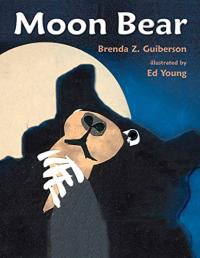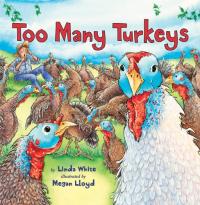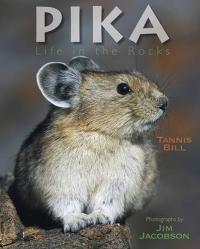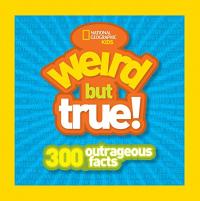
Lyrical questions and answers and textured collage illustrations introduce the Moon Bear and its seasonal habits. Additional information about this endangered animal is appended to add another dimension.
Moon Bear

Each double page begins with a question, “Look very closely. What do you see?” and a partial photograph. A page turn provides the answer and the contextualized image as well as a bit more information about the rainforest plant or animal.
Looking Closely in the Rain Forest

As Immi fishes through an ice hole, she finds a host of colorful objects beginning with a red bird. Each item ultimately decorates her igloo, introduces her to animal friends, and speaks to the power of imagination. At the end of the season, Immi sends her white bear into the hole; it is then found by a child on a tropical beach.
Immi’s Gift

The rescue of a baby snow leopard named Leo found on a mountain in northern Pakistan is chronicled in handsome, well-captioned photographs and detailed text. The collaboration between Pakistan and the United States results in a new home for Leo and the possibility of new ways to help endangered animals.
The Snow Leopard: The True Story of an Amazing Rescue

Elsie and her father leave Boston to begin afresh after Elsie’s mother dies. Elsie takes with her a pet canary. It is Timmy Tune and a host of other animals that help Elsie turn “her house into a true prairie home.” Lyrical language and evocative watercolors tell a touching story.
Elsie’s Bird

A variety of animals are presented, beginning with “The Lion/[that]stands alone/on the grassy plain…” A large format supports the bold, open woodcut and watercolor illustrations and evocative poetry that will read aloud well.
In the Wild

Owen Jester finally captures the biggest frog in the world and names him Tooley Graham, but Owen has an even bigger secret — after hearing a crash in the night, he discovers that a two-passenger submarine that has fallen off a passing train.. What Owen and his buddies along with a know-it-all girl do with that secret creates a memorable adventure, deftly told.
The Fantastic Owen Jester

Known for his close-up, full-color photographs of animals in the wild, Bishop turns his lens to a variety of lizards from around the globe. The informative, striking book demonstrates that “lizards lead lives that are full of surprises.”
Lizards

Highly realistic illustrations and brief, lucid text introduce birds of prey that live in many different habitats. A glossary, additional information about the habitats depicted, and bibliography complete this informative, engaging introduction to raptors.
About Raptors: A Guide for Children

This look at one local farm presents a look at work on a farm raising food and animals while protecting the environment. Handsome photographs show the uniqueness of the seasons.
Up We Grow! A Year in the Life of a Small, Local Farm

Fred and Belle take in a small turkey, naming him Buford. Thanks to Buford’s insect eating (and his droppings), Belle’s garden is the best around; that is, until wild turkeys join him on the small farm. Fred’s creativity humorously resolves the problem — maybe.
Too Many Turkeys

Earth’s recipe for the food we eat — seed, soil, and sun — are presented in crisp photographs and brief, lucid text all in a large format. Young scientists (and their adults) may be inspired to start their own seeds but observe their world more closely.
Seed, Soil, Sun: Earth’s Recipe for Food

A large format is used for detailed, expressive illustrations to create a portrait of a contemporary farm. When combined with lyrical language, the changing seasons, information about planting and animals, and farm life are successfully presented.
Farm

A stick-figure boy enlivens his dreary town called Cementland when he discovers and plants a treasure. To protect it from robbers, he creates a scarecrow-like creature from various paraphernalia but winds up befriending the thieves. Hand-written text ideally complements the rich, active illustrations.
The Story of Frog Belly Rat Bone

Billy has heard there is a hole in the ozone layer at the North Pole. With the help of a polar bear, he set out to try to repair the hole.
A Hole at the Pole

A child and her grandfather place a wooden box high in a tree near where they have seen owl pellets. As they watch from below, child and adult observe a white barn owl fly into the nest box, call for its mate, and ultimately raise its young. The engaging story is richly illustrated, enhanced by additional information provided in a different typeface.
White Owl, Barn Owl

The author has long observed birds and recorded her findings in journals. This handsome book provides a glimpse into those observations combined with a variety of poems about her feathered subjects. Notes about her writing and additional resources are sure to inspire similar activities by young scientists.
The Robin Makes a Laughing Sound: A Birder’s Journal

Planning a visit to the mountains of the American West this summer? If you’re sharp-eyed, you may see a well-camouflaged pika. These 6-8 inch animals are related to hares and rabbits (although in the crisp, expressive pictures they resemble large hamsters!). Color photographs and snappy text provide a fascinating look into pikas’ habitat, behaviors, and predators. Additional information is included at the end of the book.
Pika: Life in the Rocks

Meet a family of howler monkeys (who get their name from the loud calls they make “Woo-hoo-hoo! AH-UH-OH!”). An engaging, rhyming text that introduces their habits and where they live combines with soft-lined, richly colored illustrations. Additional factual material is presented on each double-page in a different typeface. A map and greater detail conclude this informative, appealing book.
Meet the Howlers

Bees have been around for over 65 million years but have been in decline since early in the 21st century. This scientific mystery is better appreciated with a clearer understanding of the importance of these flying insects to humans. Mystery and background information are presented in handsome photographs and lucid text. Suggested activities are doable as is finding out more from recommended resources.
The Buzz on Bees: Why Are They Disappearing?

In the Spring, apple blossoms draw buzzing bees. The blossoms slowly grow into apples that are ready to pick in the fall. Younger children can explore apples from seed to table in brief text and stunning photographs. Similarly, children can thank bees in the Spring for their fall jack-o-lanterns, shown from start to finish in Seed, Spout, Pumpkin Pie (opens in a new window).
Apples for Everyone

Did you know that slugs have “3,000 teeth and 4 noses” or that in “elephants sometimes make purr-like sounds when content”? These and other factoids are presented in a highly designed format just right to amaze and to pique curiosity. An index allows easy access to the brief information.
Weird but True! 300 Outrageous Facts

Meet a sea anemone, sea urchin, a sculpin and other inhabitants of a tide pool through poems (in each creature’s voice) and an informative paragraph (in a different typeface). Cartoon-like illustrations complete the engaging animal introductions while additional information is provided.
Ocean Soup: Tide-Pool Poems

Two different environments, two different authors, one goal achieved: to bring alive the process of studying and documenting a fascinating mammal and insect. Both books use the same basic format and text features, stunning photographs, and an informal voice to great effect. This is a series not to be missed. See also: Face to Face with Butterflies (opens in a new window)
